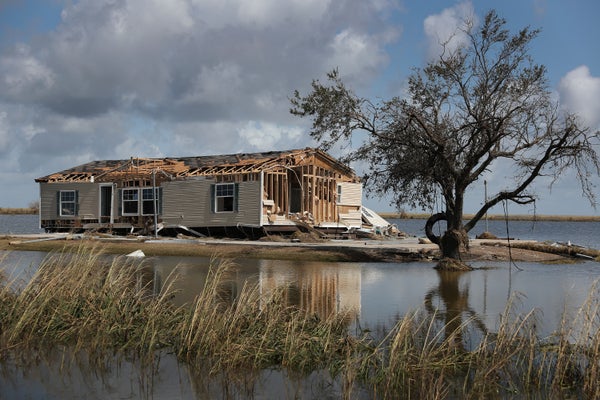Hurricane season is drawing to a close, but not before setting a record. Tropical Storm Theta became the 29th named Atlantic storm this week, making 2020 the busiest season on record.
And it’s not just the total number of storms that’s remarkable. At least nine storms this year underwent a process known as rapid intensification, quickly gathering strength over a short period of time as they moved across the ocean.
According to at least one expert, only 1995 saw more storms rapidly intensify in a single season.
On supporting science journalism
If you're enjoying this article, consider supporting our award-winning journalism by subscribing. By purchasing a subscription you are helping to ensure the future of impactful stories about the discoveries and ideas shaping our world today.
Experts have attributed the flurry of storms, and the speed at which they’ve strengthened, in part to abnormally warm oceans this year.
This season’s unusual activity has reignited scientific discussions about the ways in which climate change may affect future hurricane activity. And now, just a few weeks before hurricane season officially ends, scientists have identified yet another way warming waters may influence Atlantic storms.
As ocean waters heat up, cyclones may be able to hold their strength for longer as they move over land, according to a study published this week in Nature.
It’s a topic that’s been largely overlooked by hurricane research so far, according to study authors Lin Li and Pinaki Chakraborty, scientists at Okinawa Institute of Science and Technology Graduate University in Japan.
“As is not uncommon in research, we stumbled our way into this problem,” Chakraborty told E&E News in an email.
The authors were studying the evolution of landfalling hurricanes using model simulations. They kept noticing strange features in the storms’ behaviors that they couldn’t immediately explain.
Eventually, they realized that there was a likely link between climate change and a hurricane’s behavior after landfall.
“And that led us to this study,” Chakraborty said.
The new study examined records of hurricanes hitting North America over the last 50 years. It found that these storms are weakening more slowly over time.
In the late 1960s, a typical hurricane would lose about 75% of its strength in the first 24 hours after making landfall. Today, a comparable storm loses only about half its intensity in the same amount of time.
Generally speaking, hurricanes start weakening the second they make landfall. That’s mainly because hurricanes draw energy from the ocean’s heat—and once that energy source disappears, the storm begins to decay.
As a result, hurricanes tend to inflict less damage as they move inland, typically fizzling out entirely within a few days.
The new study suggests that rising ocean temperatures may help slow down this effect. Warmer waters allow hurricanes to store more moisture. And wetter hurricanes decay more slowly.
The researchers investigated using a model that simulates the behavior of hurricanes. The model suggested that sea surface temperatures were the cause of the slower-weakening trend.
To find out why this was happening, the researchers ran a series of simulations involving both normal hurricanes and “dry” hurricanes—storms containing no moisture at all. The dry hurricanes weakened far faster than their wet counterparts.
There may be one other factor contributing to the 50-year trend, the researchers note. It’s probably still related to climate change—but it’s likely secondary to the warming oceans.
Some studies suggest that Atlantic hurricanes shift eastward as the climate warms, meaning they’re more likely to make landfall on the East Coast than the Caribbean or the Gulf of Mexico. And hurricanes tend to weaken more slowly in eastern regions.
Why this happens is still a mystery, according to Chakraborty. It might have something to do with landscape differences on the East Coast versus the Gulf Coast. Or it could involve differences in wind conditions. But scientists still don’t know for sure.
The new study looks only at Atlantic hurricanes making landfall in North America. It doesn’t necessarily indicate that the same patterns are happening elsewhere around the world.
But Chakraborty suspects similar trends are true in other places.
“We have done a preliminary analysis of typhoons in the Pacific basin and we find that our main results ... hold for this basin,” he said.
As temperatures continue to rise, he expects these trends to continue.
If that’s the case, hurricanes could inflict more damage in the future. If storms hold their strength longer, they could pose a bigger threat both to coastal areas and to inland communities as they move across land.
That’s on top of all the other ways climate change may juice hurricanes in the coming years. Studies suggest that warming also contributes to stronger storms, with higher wind speeds and more rainfall.
Put together, these factors would likely exacerbate the damaging influence of slower-decaying storms, according to Purdue University researchers Dan Chavas and Jie Chen. In a published comment on the new research, they noted that the new study “highlights a key component of risk models that has been largely overlooked so far.”
“More generally, the current results indicate the need to broaden our thinking about how climate change affects tropical cyclones after landfall,” they wrote. “Integrating this understanding into hurricane models should help to improve our predictions of the future risks posed by individual storms and over the long term.”
Reprinted from Climatewire with permission from E&E News. E&E provides daily coverage of essential energy and environmental news at www.eenews.net.
